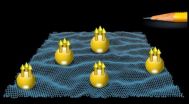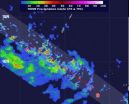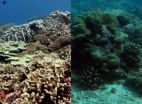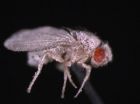(Press-News.org) Introducing graphene
One of the hottest materials in condensed matter research today is graphene.
Graphene had an unlikely start: it began with researchers messing around with pencil marks on paper. Pencil "lead" is actually made of graphite, which is a soft crystal lattice made of nothing but carbon atoms. When pencils deposit that graphite on paper, the lattice is laid down in thin sheets. By pulling that lattice apart into thinner sheets – originally using Scotch tape – researchers discovered that they could make flakes of crystal just one atom thick.
The name for this atom-scale chicken wire is graphene. Those folks with the Scotch tape, Andre Geim and Konstantin Novoselov, won the 2010 Nobel Prize for discovering it. "As a material, it is completely new – not only the thinnest ever but also the strongest," wrote the Nobel committee. "As a conductor of electricity, it performs as well as copper. As a conductor of heat, it outperforms all other known materials. It is almost completely transparent, yet so dense that not even helium, the smallest gas atom, can pass through it."
Developing a theoretical model of graphene
Graphene is not just a practical wonder – it's also a wonderland for theorists. Confined to the two-dimensional surface of the graphene, the electrons behave strangely. All kinds of new phenomena can be seen, and new ideas can be tested. Testing new ideas in graphene is exactly what Perimeter researchers Zlatko Papić and Dmitry (Dima) Abanin set out to do.
"Dima and I started working on graphene a very long time ago," says Papić. "We first met in 2009 at a conference in Sweden. I was a grad student and Dima was in the first year of his postdoc, I think."
The two young scientists got to talking about what new physics they might be able to observe in the strange new material when it is exposed to a strong magnetic field.
"We decided we wanted to model the material," says Papić. They've been working on their theoretical model of graphene, on and off, ever since. The two are now both at Perimeter Institute, where Papić is a postdoctoral researcher and Abanin is a faculty member. They are both cross-appointed with the Institute for Quantum Computing (IQC) at the University of Waterloo.
In January 2014, they published a paper in Physical Review Letters (PRL) presenting new ideas about how to induce a strange but interesting state in graphene – one where it appears as if particles inside it have a fraction of an electron's charge.
It's called the fractional quantum Hall effect (FQHE), and it's head turning. Like the speed of light or Planck's constant, the charge of the electron is a fixed point in the disorienting quantum universe.
Every system in the universe carries whole multiples of a single electron's charge. When the FQHE was first discovered in the 1980s, condensed matter physicists quickly worked out that the fractionally charged "particles" inside their semiconductors were actually quasiparticles – that is, emergent collective behaviours of the system that imitate particles.
Graphene is an ideal material in which to study the FQHE. "Because it's just one atom thick, you have direct access to the surface," says Papić. "In semiconductors, where FQHE was first observed, the gas of electrons that create this effect are buried deep inside the material. They're hard to access and manipulate. But with graphene you can imagine manipulating these states much more easily."
In the January paper, Abanin and Papić reported novel types of FQHE states that could arise in bilayer graphene – that is, in two sheets of graphene laid one on top of another – when it is placed in a strong perpendicular magnetic field. In an earlier work from 2012, they argued that applying an electric field across the surface of bilayer graphene could offer a unique experimental knob to induce transitions between FQHE states. Combining the two effects, they argued, would be an ideal way to look at special FQHE states and the transitions between them.
Experimental tests
Two experimental groups – one in Geneva, involving Abanin, and one at Columbia, involving both Abanin and Papić – have since put the electric field + magnetic field method to good use. The paper by the Columbia group appears in the July 4 issue of Science . A third group, led by Amir Yacoby of Harvard, is doing closely related work.
"We often work hand in hand with experimentalists," says Papić. "One of the reasons I like condensed matter is that often even the most sophisticated, cutting-edge theory stands a good chance of being quickly checked with experiment."
Inside both the magnetic and electric field, the electrical resistance of the graphene demonstrates the strange behaviour characteristic of the FQHE. Instead of resistance that varies in a smooth curve with voltage, resistance jumps suddenly from one level to another, and then plateaus – a kind of staircase of resistance. Each stair step is a different state of matter, defined by the complex quantum tangle of charges, spins, and other properties inside the graphene.
"The number of states is quite rich," says Papić. "We're very interested in bilayer graphene because of the number of states we are detecting and because we have these mechanisms – like tuning the electric field – to study how these states are interrelated, and what happens when the material changes from one state to another."
For the moment, researchers are particularly interested in the stair steps whose "height" is described by a fraction with an even denominator. That's because the quasiparticles in that state are expected to have an unusual property.
There are two kinds of particles in our three-dimensional world: fermions (such as electrons), where two identical particles can't occupy one state, and bosons (such as photons), where two identical particles actually want to occupy one state. In three dimensions, fermions are fermions and bosons are bosons, and never the twain shall meet.
But a sheet of graphene doesn't have three dimensions – it has two. It's effectively a tiny two-dimensional universe, and in that universe, new phenomena can occur. For one thing, fermions and bosons can meet halfway – becoming anyons, which can be anywhere in between fermions and bosons. The quasiparticles in these special stair-step states are expected to be anyons.
In particular, the researchers are hoping these quasiparticles will be non-Abelian anyons, as their theory indicates they should be. That would be exciting because non-Abelian anyons can be used in the making of qubits.
Graphene qubits?
Qubits are to quantum computers what bits are to ordinary computers: both a basic unit of information and the basic piece of equipment that stores that information. Because of their quantum complexity, qubits are more powerful than ordinary bits and their power grows exponentially as more of them are added. A quantum computer of only a hundred qubits can tackle certain problems beyond the reach of even the best non-quantum supercomputers. Or, it could, if someone could find a way to build stable qubits.
The drive to make qubits is part of the reason why graphene is a hot research area in general, and why even-denominator FQHE states – with their special anyons– are sought after in particular. "A state with some number of these anyons can be used to represent a qubit," says Papić. "Our theory says they should be there and the experiments seem to bear that out – certainly the even-denominator FQHE states seem to be there, at least according to the Geneva experiments."
That's still a step away from experimental proof that those even-denominator stair-step states actually contain non-Abelian anyons. More work remains, but Papić is optimistic: "It might be easier to prove in graphene than it would be in semiconductors. Everything is happening right at the surface."
It's still early, but it looks as if bilayer graphene may be the magic material that allows this kind of qubit to be built. That would be a major mark on the unlikely line between pencil lead and quantum computers.
INFORMATION:
Further exploration
January PRL paper mentioned above: http://journals.aps.org/prl/abstract/10.1103/PhysRevLett.112.046602
Experimental paper from the Geneva graphene group, including Abanin: http://pubs.acs.org/doi/abs/10.1021/nl5003922
Experimental paper from the Columbia graphene group, including both Abanin and Papić: http://arxiv.org/abs/1403.2112. This paper is featured in the journal Science.
Related experiment on bilayer graphene by Amir Yacoby's group at Harvard: http://www.sciencemag.org/content/early/2014/05/28/science.1250270
The Nobel Prize press release on graphene, mentioned above: http://www.nobelprize.org/nobel_prizes/physics/laureates/2010/press.html
From pencil marks to quantum computers
2014-07-03
ELSE PRESS RELEASES FROM THIS DATE:
Payback time for soil carbon from pasture conversion to sugarcane production
2014-07-03
The reduction of soil carbon stock caused by the conversion of pasture areas into sugarcane plantations – a very common change in Brazil in recent years – may be offset within two or three years of cultivation.
The calculation appears in a study conducted by researchers at the Center for Nuclear Energy in Agriculture (CENA) of the University of São Paulo (USP) in collaboration with colleagues from the Luiz de Queiroz College of Agriculture (Esalq), also at USP. The study also included researchers from the Federal Institute of Alagoas (IFAL), the Brazilian Bioethanol Science ...
New satellite data like an ultrasound for baby stars
2014-07-03
An international team of researchers have been monitoring the "heartbeats" of baby stars to test theories of how the Sun was born 4.5 billion years ago.
In a paper published in Science magazine today, the team of 20 scientists describes how data from two space telescopes – the Canadian Space Agency's MOST satellite and the French CoRoT mission – have unveiled the internal structures and ages of young stars before they've even emerged as full-fledged stars.
"Think of it as ultrasound of stellar embryos," explains University of British Professor Jaymie Matthews, MOST ...
A young star's age can be gleamed from nothing but sound waves
2014-07-03
VIDEO:
In a young region like the so-called Christmas Tree Cluster, stars are still in the process of forming. A star is 'born' once it becomes optically visible (bottom right). During...
Click here for more information.
Determining the age of stars has long been a challenge for astronomers. In experiments published in the journal Science, researchers at KU Leuven's Institute for Astronomy show that 'infant' stars can be distinguished from 'adolescent' stars by measuring the acoustic ...
Sweet genes
2014-07-03
Edmonton, July 3, 2014 – A research team at the Faculty of Medicine & Dentistry at the University of Alberta have discovered a new way by which metabolism is linked to the regulation of DNA, the basis of our genetic code. The findings may have important implications for the understanding of many common diseases, including cancer.
The DNA wraps around specialized proteins called histones in the cell's nucleus. Normally, histones keep the DNA tightly packaged, preventing the expression of genes and the replication of DNA, which are required for cell growth and division. ...
NASA sees rainfall in newborn Tropical Depression 8W
2014-07-03
Powerful thunderstorms in some areas of newborn Tropical Depression 08W in the Northwestern Pacific Ocean were dropping heavy rainfall on July 3 as NASA's Tropical Rainfall Measuring Mission (TRMM) satellite passed overhead.
The eighth depression of the Northwestern Pacific Ocean season formed on July 3 at 0900 UTC (5 a.m. EDT). It was located near 10.0 north latitude and 144.3 east longitude about 240 nautical miles south of Andersen Air Force Base, Guam. Tropical Depression 08W or TD08W had maximum sustained winds near 30 knots (34.5 mph/55.5 kph) and it was moving ...
Safer, cheaper building blocks for future anti-HIV and cancer drugs
2014-07-03
A team of researchers from KU Leuven, in Belgium, has developed an economical, reliable and heavy metal-free chemical reaction that yields fully functional 1,2,3-triazoles. Triazoles are chemical compounds that can be used as building blocks for more complex chemical compounds, including pharmaceutical drugs.
Leveraging the compound's surprisingly stable structure, drug developers have successfully used 1,2,3-triazoles as building blocks in various anti-HIV, anti-cancer and anti-bacterial drugs. But efforts to synthesize the compound have been hampered by one serious ...
Tropical Storm Douglas weakening in the eastern Pacific
2014-07-03
Tropical Storm Douglas is on a weakening trend, according to the National Hurricane Center, and satellite imagery showed that the storm appeared more elongated on July 3.
NOAA's Geostationary Operational Environmental Satellite or GOES-West satellite captured visible data on Douglas just after sunrise on July 3 at 13:15 UTC (9:15 a.m. EDT). The data from GOES-West was made into an image at NASA/NOAA's GOES Project at the NASA Goddard Space Flight Center in Greenbelt, Md.
Forecaster Stewart at the National Hurricane Center cited that Douglas' thunderstorm activity had ...
Rethinking the reef
2014-07-03
A new study by biologists at San Diego State University and Scripps Institution of Oceanography shows that inhabited coral islands that engage in commercial fishing dramatically alter their nearby reef ecosystems, disturbing the microbes, corals, algae and fish that call the reef home.
The study's lead author, Linda Wegley Kelly, is a postdoctoral scholar in the lab of SDSU virologist Forest Rohwer.
For the study, she looked at seawater samples collected from the surfaces of reefs surrounding all 11 of the Line Islands, a chain of atolls in the central Pacific Ocean. ...
Fruit fly immunity fails with fungus after (space)flight
2014-07-03
Before you swat away the next fruit fly, consider instead just how similar its biological complexities are to our own. In a study published in PLOS ONE, researchers led by Deborah Kimbrell, Ph.D., at the University of California, Davis (UC Davis) and their collaborators, studied how microorganisms may alter fruit flies' immunity in space and in hypergravity, or increased gravity. The article is titled "Toll Mediated Infection Response Is Altered by Gravity and Spaceflight in Drosophila."
This study suggests that having normal gravity or hypergravity on the space station ...
Drug shows promise for effectively treating metabolic syndrome
2014-07-03
(SALT LAKE CITY)—University of Utah researchers have discovered that an enzyme involved in intracellular signaling plays a crucial role in developing metabolic syndrome, a finding that has a U of U spinoff company developing a drug to potentially treat the condition.
The researchers, led by Jared Rutter, Ph.D., professor of biochemistry, hope to begin human clinical trials of a drug in the next couple of years.
"The approved drug therapies do not treat or prevent this condition in most people," says Rutter, senior author of a study describing the research published ...





